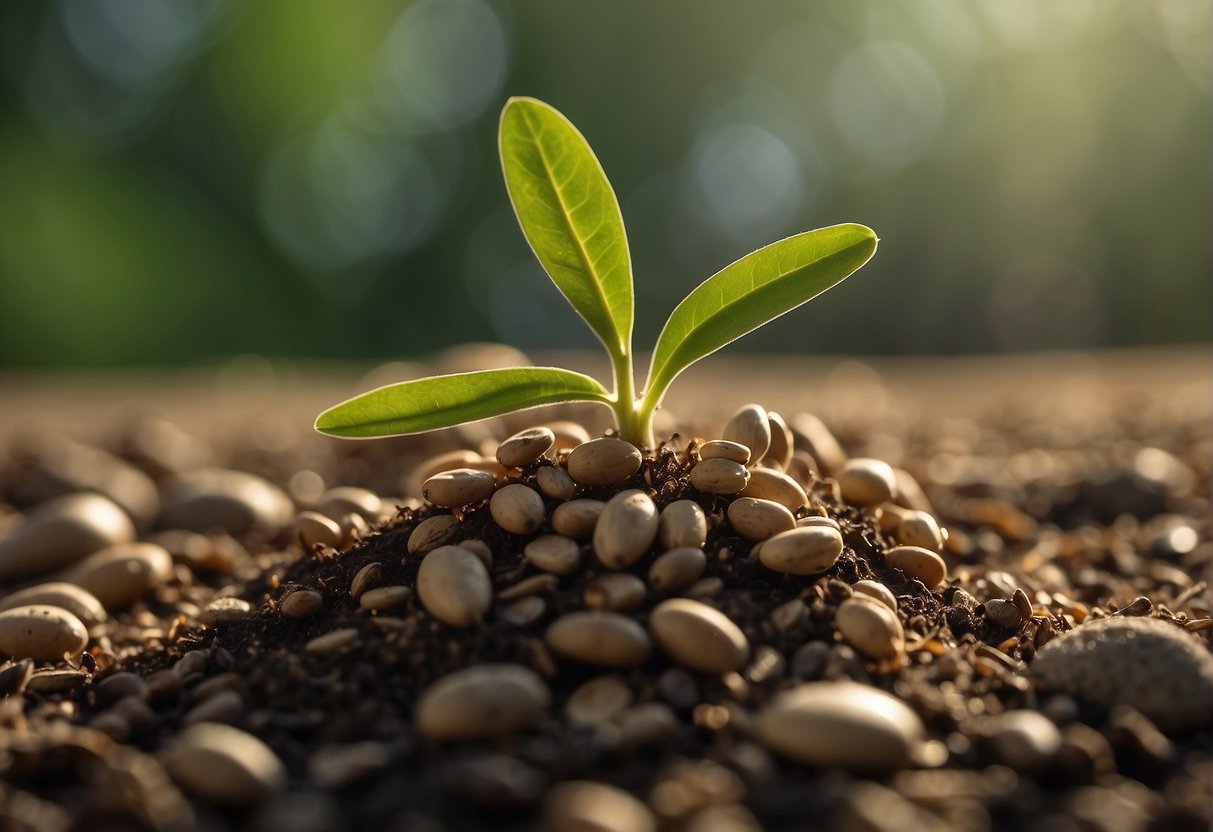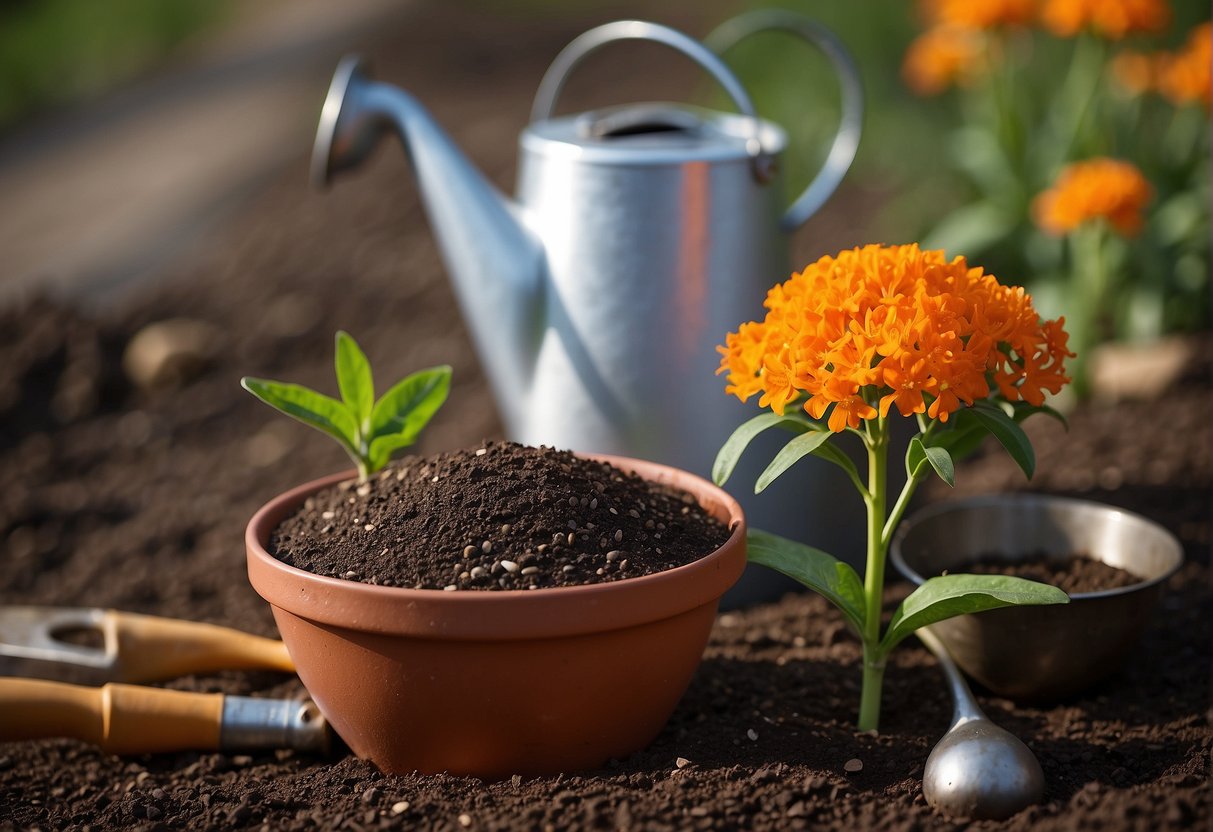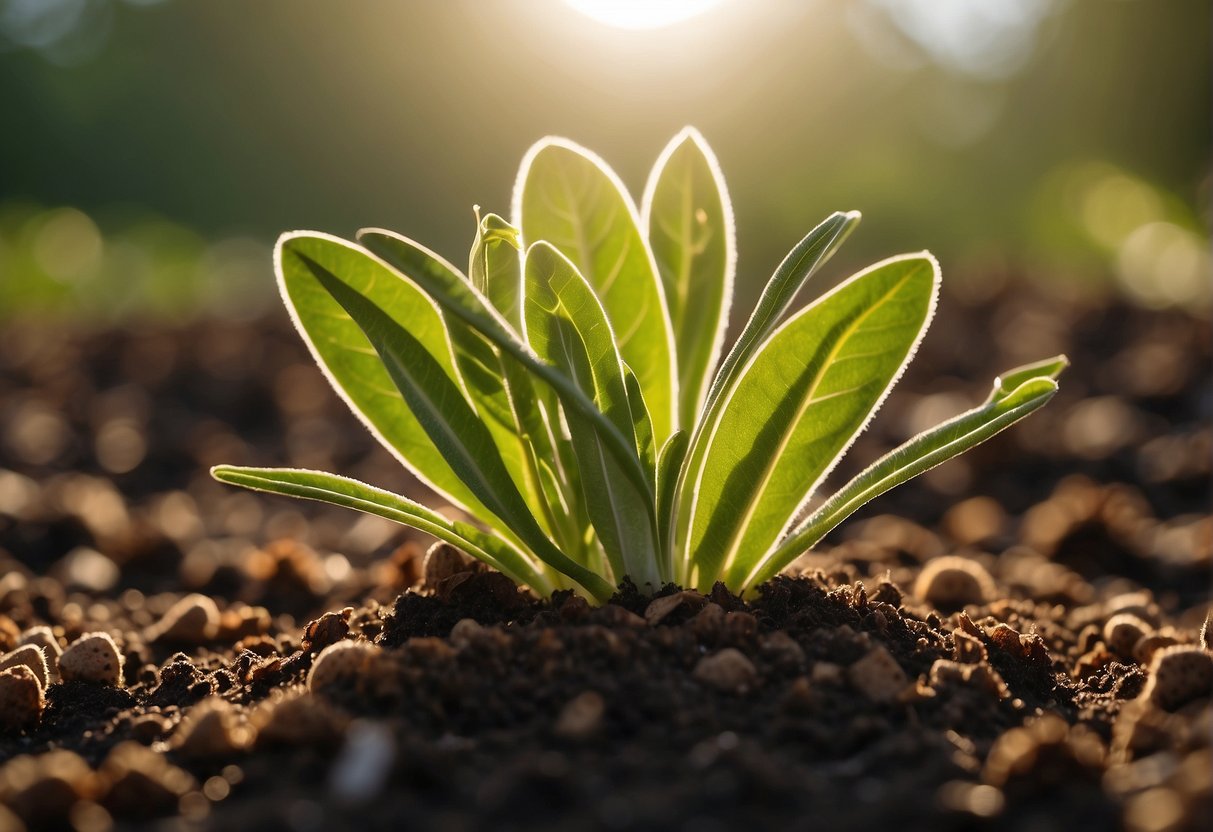How to Germinate Butterfly Milkweed Seeds: A Clear Guide
Butterfly milkweed is a captivating and significant flora indigenous to North America. It holds a special place in the hearts of both horticulturists and environmentalists due to its role as a host for monarch butterflies and its ability to supply nectar to numerous pollinating species. To successfully cultivate butterfly milkweed in your garden, understanding the germination process of its seeds is crucial.

Understanding milkweed seed germination is essential for successfully growing butterfly milkweed. Milkweed seeds have a unique germination process that requires a period of cold stratification before they will sprout. This means that the seeds need to be exposed to cold temperatures for a certain amount of time before they will be ready to grow. By following a few simple steps, you can easily germinate butterfly milkweed seeds and start your own milkweed plants.
Key Takeaways
- Butterfly milkweed is a native plant that is important for monarch butterflies and other pollinators.
- Milkweed seeds require a period of cold stratification before they will sprout.
- By following a few simple steps, you can easily germinate butterfly milkweed seeds and start your own milkweed plants.
Understanding Milkweed Seed Germination
If you’re looking to grow butterfly milkweed from seed, understanding the germination process is crucial. Here’s what you need to know:
The Lifecycle of Butterfly Milkweed
Butterfly milkweed is a perennial plant that grows in the wild across North America. It is a member of the milkweed family, which includes over 100 species. The plant produces flowers in the summer, which are followed by seed pods in the fall. Each pod contains dozens of seeds, which are dispersed by the wind.
Importance for Monarch Butterflies
Milkweed is the only plant that monarch butterfly larvae can eat. Without it, the species would not survive. By planting butterfly milkweed in your garden, you are providing a crucial habitat for monarch butterflies and helping to ensure their survival.
To germinate butterfly milkweed seeds, you’ll need to mimic the natural conditions that the seeds would experience in the wild. This means planting them in the fall, so that they can go through a period of cold stratification over the winter. In the spring, the seeds will germinate and begin to grow.
Overall, growing butterfly milkweed from seed is a rewarding experience that can help to support the monarch butterfly population. By understanding the germination process and providing the right growing conditions, you can successfully grow this beautiful and important plant in your own garden.
Preparing for Planting

Before planting butterfly milkweed seeds, it is important to properly prepare them to increase the chances of successful germination. This section will cover two important aspects of seed preparation: choosing the right seeds and the stratification process.
Choosing the Right Seeds
When selecting butterfly milkweed seeds, it is important to choose those that are fresh and have been harvested within the last year. Look for seeds that are plump and have a light brown color. Avoid seeds that are shriveled or have a dark brown or black color, as they may be old or damaged.
Stratification Process Explained
Butterfly milkweed seeds require stratification, which is a process of exposing the seeds to cold temperatures to simulate winter conditions. This process is necessary because the seeds have a hard outer coat that prevents water and air from penetrating, making it difficult for them to germinate.
To stratify butterfly milkweed seeds, you can follow these simple steps:
- Moisten a paper towel with water and wring out the excess.
- Place the seeds on one half of the damp paper towel and fold the other half over the seeds.
- Place the paper towel with the seeds in a plastic bag and seal it.
- Label the bag with the date and the name of the plant.
- Place the bag in the refrigerator for 4-6 weeks, checking the moisture level periodically to make sure the paper towel remains damp.
Once the stratification process is complete, the seeds are ready to be planted. By following these steps, you can increase the chances of successful germination and enjoy the beautiful blooms of butterfly milkweed in your garden.
Planting Milkweed Seeds

If you want to grow butterfly milkweed from seed, there are two main ways to get started: indoor seed starting and direct sowing outdoors. Both methods can be effective, but each has its own advantages and disadvantages.
Indoor Seed Starting
Indoor seed starting is a great option if you want to get a head start on the growing season or if you live in an area with a short growing season. To get started, you will need a seed starting mix, a seed tray, and some potting soil.
First, fill the seed tray with the seed starting mix, making sure to leave a little space at the top. Then, sprinkle the milkweed seeds on top of the mix, spacing them out evenly. Cover the seeds with a thin layer of potting soil, and then mist the soil with water until it is moist but not soaking wet.
Place the seed tray in a warm, sunny location and keep the soil moist by misting it with water as needed. Once the seedlings have grown a few inches tall and have developed their first set of true leaves, you can transplant them into larger pots or directly into the garden.
Direct Sowing Outdoors
Direct sowing outdoors is a good option if you live in an area with a long growing season or if you want to save time and effort. To get started, you will need to wait until the soil has warmed up in the spring and all danger of frost has passed.
Choose a sunny location with well-draining soil and prepare the soil by removing any weeds or debris. Then, scatter the milkweed seeds over the soil and cover them with a thin layer of soil. Water the area gently to settle the soil, and then keep the soil moist until the seeds germinate.
It’s important to note that butterfly milkweed seeds need a period of cold stratification in order to germinate. This means that they need to be exposed to cold temperatures (around 40°F) for several weeks before they will sprout. If you are planting in the fall, you can simply scatter the seeds on the soil and let nature take its course. If you are planting in the spring, you can simulate cold stratification by placing the seeds in a plastic bag with a damp paper towel and storing them in the refrigerator for several weeks before planting.
By following these simple steps, you can successfully grow butterfly milkweed from seed and help support the monarch butterfly population in your area.
Caring for Milkweed Seedlings
Once your butterfly milkweed seeds have germinated, it’s important to provide proper care to ensure healthy growth. Here are some tips on how to care for your milkweed seedlings.
Watering and Moisture Control
Water is essential for the growth of milkweed seedlings. It’s important to keep the soil moist, but not waterlogged. Overwatering can lead to root rot and other problems. To prevent this, water your seedlings when the top inch of soil feels dry to the touch.
To avoid disturbing the delicate seedlings, use a watering can with a fine nozzle or a spray bottle. Water the soil around the seedlings, not the leaves. This will help prevent fungal diseases and other problems.
Light and Temperature Requirements
Butterfly milkweed seedlings require plenty of light to grow properly. Place them in a sunny window or under a grow light for 12-14 hours a day. If you’re using a grow light, keep it about 6 inches above the seedlings.
Temperature is also important for the growth of milkweed seedlings. They prefer warm temperatures between 70-85°F (21-29°C). Keep them away from cold drafts and air conditioning vents.
By following these simple tips, you can ensure healthy growth and development of your butterfly milkweed seedlings. Remember to monitor their progress regularly and adjust care as needed.
Transplanting and Acclimatization
When to Transplant Seedlings
Once your butterfly milkweed seedlings have developed their second set of true leaves, it’s time to transplant them into larger containers or outdoors. This usually happens around 4-6 weeks after germination.
It’s important to wait until the danger of frost has passed before transplanting your seedlings outdoors. Check your local weather forecast to determine when the last frost is expected in your area.
Hardening Off Process
Before transplanting your seedlings outdoors, it’s important to acclimate them to their new environment through a process called “hardening off.” This process involves gradually exposing your seedlings to outdoor conditions over the course of a week or two.
Start by placing your seedlings outdoors in a shaded area for a few hours each day, gradually increasing the amount of time they spend outside. After a few days, move them to a sunnier area for a few hours each day, gradually increasing their exposure to direct sunlight.
During the hardening off process, make sure to keep your seedlings well-watered and protected from extreme weather conditions, such as strong winds or heavy rain.
By following these steps, you can ensure that your butterfly milkweed seedlings are well-prepared for life outdoors and have the best chance of thriving in their new environment.
Maintaining a Healthy Milkweed Population
As you work on germinating your butterfly milkweed seeds, it’s important to also consider how to maintain a healthy milkweed population in your garden or outdoor space. Here are some tips to help you keep your milkweed plants thriving:
Pest and Disease Management
Like any plant, milkweed is susceptible to pests and diseases that can damage or kill the plants. One of the most common pests that affect milkweed is aphids. These small insects feed on the sap of the plant and can cause wilting and yellowing of the leaves. To control aphids, you can use insecticidal soap or neem oil. These products are safe for the environment and won’t harm beneficial insects like bees and butterflies.
Another common issue with milkweed is fungal diseases, which can cause black spots or powdery mildew on the leaves. To prevent fungal diseases, make sure your milkweed plants have good air circulation and avoid overhead watering. If you do notice signs of a fungal disease, you can use a fungicide to treat the plants.
Promoting Pollinators and Biodiversity
Milkweed is an important plant for pollinators like bees and butterflies. To promote a healthy milkweed population, it’s important to also consider how to attract and support these beneficial insects. One way to do this is to plant other native flowers and plants that bloom at different times throughout the year. This will provide food and habitat for a variety of pollinators.
You can also create a pollinator-friendly habitat by providing shelter and nesting sites for native bees. This can be done by leaving some areas of your garden or outdoor space un-mowed and providing nesting materials like hollow stems or wood blocks.
By following these tips, you can help maintain a healthy milkweed population and support pollinators and biodiversity in your garden or outdoor space.
Harvesting and Saving Milkweed Seeds
If you want to propagate butterfly milkweed, you will need to harvest and save the seeds. Here are some tips to help you successfully harvest and save milkweed seeds:
Identifying Mature Seed Pods
The first step in harvesting milkweed seeds is to identify mature seed pods. You can tell if a seed pod is mature by looking at its color. Mature seed pods are brown and dry, while immature seed pods are green and plump.
To harvest the seeds, gently twist the seed pod until it comes off the plant. You can also use scissors or pruners to cut the stem below the seed pod.
Proper Seed Storage Techniques
Once you have harvested the milkweed seeds, it’s important to store them properly to ensure they remain viable. Here are some tips for proper seed storage:
-
Dry the seeds: Lay the seed pods out in a dry, well-ventilated area for a few weeks to allow them to dry out completely. Once the pods are dry, gently open them to remove the seeds.
-
Store the seeds in a cool, dry place: Place the seeds in a paper envelope or airtight container and store them in a cool, dry place, such as a refrigerator or a cool basement.
-
Label the seeds: Be sure to label the envelope or container with the name of the plant and the date the seeds were harvested.
By following these tips, you can successfully harvest and save butterfly milkweed seeds, ensuring that you have a steady supply of seeds for future plantings.
Frequently Asked Questions
What is the optimal temperature for germinating butterfly milkweed seeds?
Butterfly milkweed seeds germinate best at temperatures between 70-75°F (21-24°C). It’s important to maintain a consistent temperature throughout the germination process.
What soil conditions are best for growing butterfly milkweed from seed?
Butterfly milkweed seeds prefer well-draining soil that is not too rich in nutrients. A mix of sand and peat moss can provide the right conditions for successful germination.
How long should butterfly milkweed seeds be cold stratified before planting?
Butterfly milkweed seeds require a period of cold stratification before planting. This process helps to break down the seed coat and prepare the seed for germination. Seeds should be stratified for 4-6 weeks in a plastic bag in the refrigerator before planting.
Can butterfly milkweed seeds be directly sown outdoors, and if so, when?
Yes, butterfly milkweed seeds can be directly sown outdoors in the fall or early spring. It’s important to wait until the soil has warmed up to at least 60°F (15°C) before planting.
What are the steps for successfully germinating butterfly milkweed seeds indoors?
To germinate butterfly milkweed seeds indoors, start by cold stratifying the seeds for 4-6 weeks in the refrigerator. After stratification, plant the seeds in a well-draining soil mix and keep them consistently moist. Provide bright, indirect light and maintain a temperature of 70-75°F (21-24°C) for best results.
How do you care for butterfly milkweed seedlings after germination?
Once the seedlings have emerged, provide them with bright, direct sunlight for at least 6 hours per day. Keep the soil consistently moist but avoid overwatering. Fertilize every 2-3 weeks with a balanced fertilizer. Transplant seedlings to larger pots or outdoors when they have developed a few sets of true leaves.


